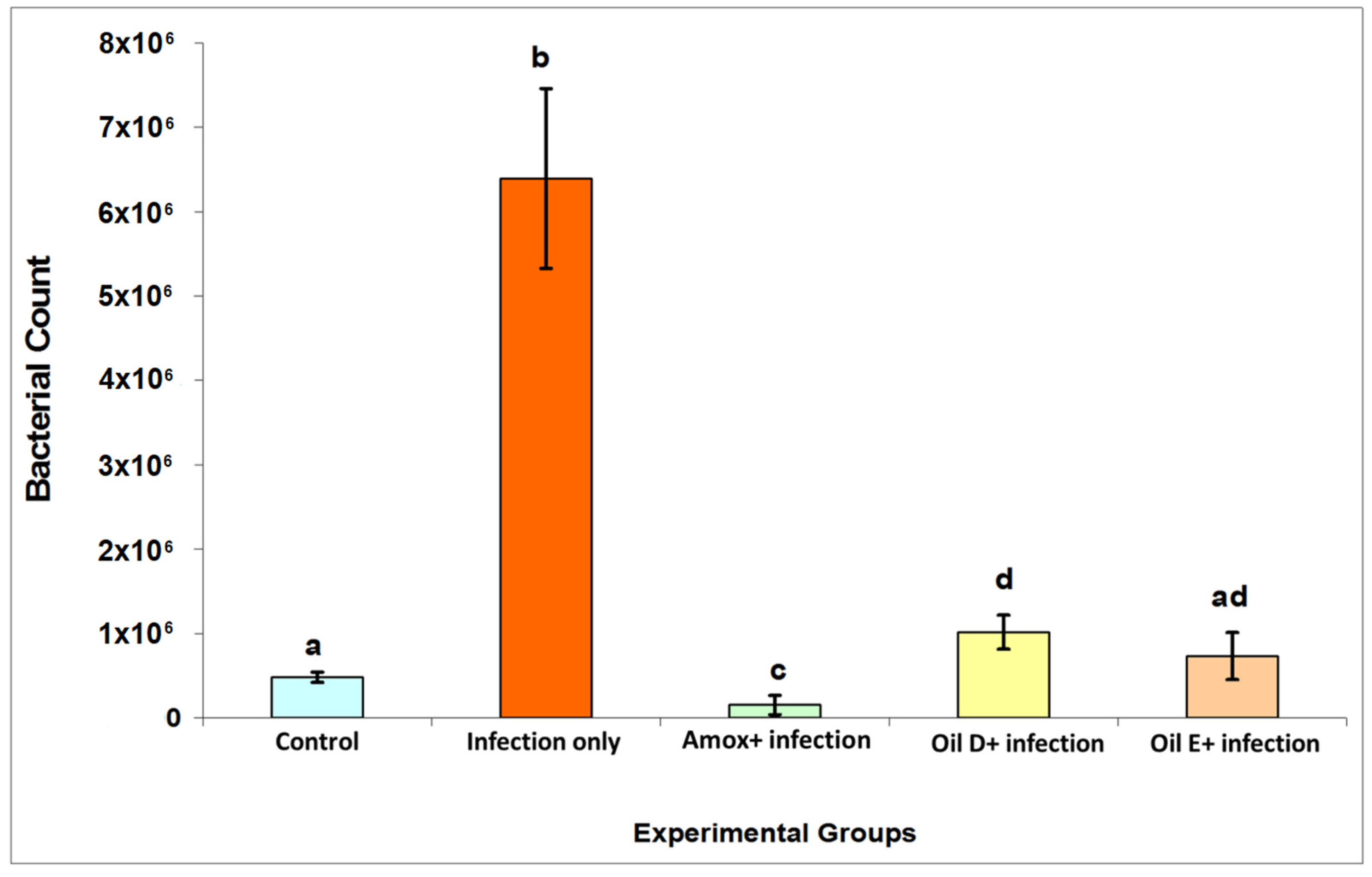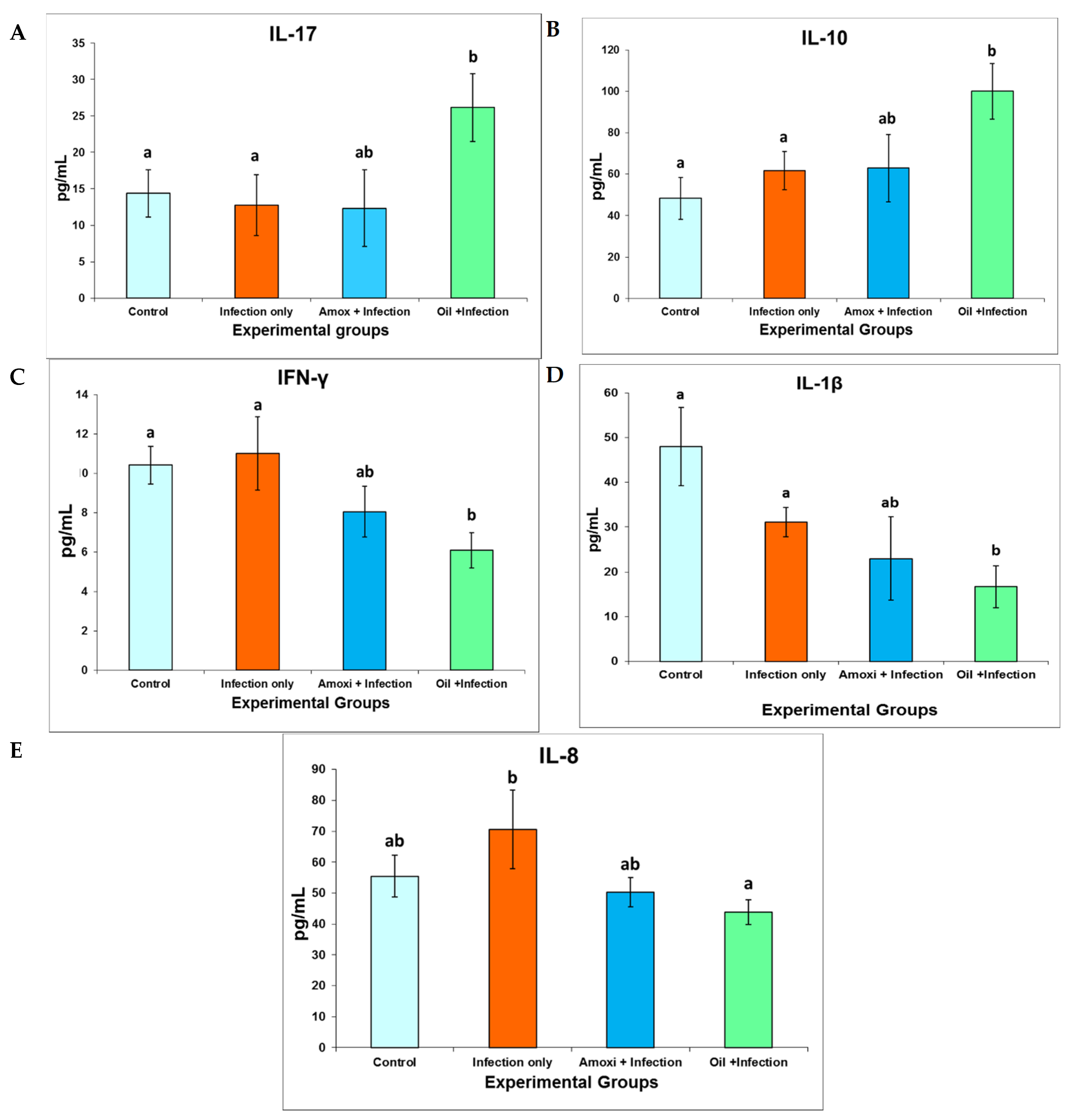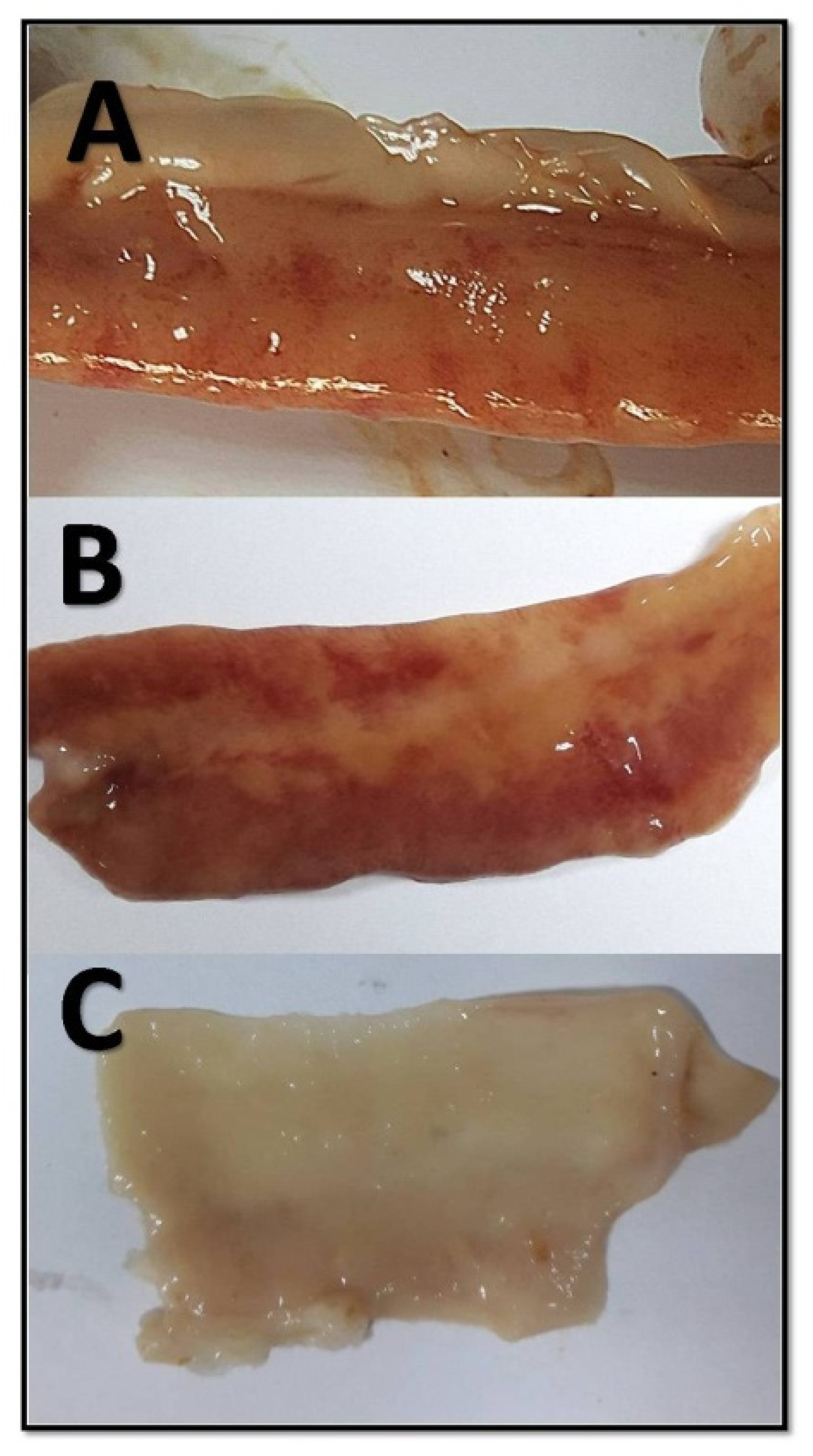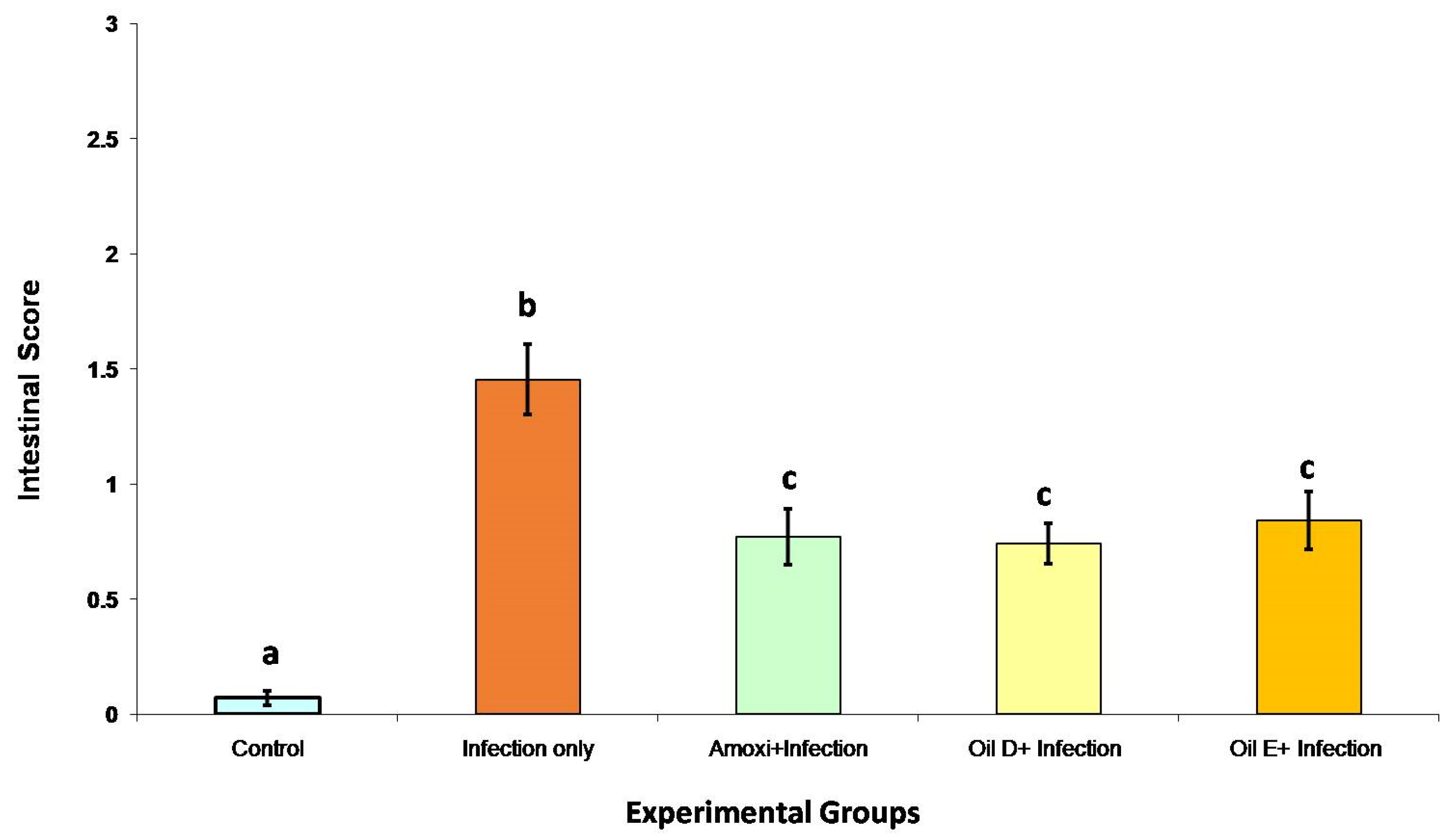Assessment of Immune Response and Efficacy of Essential Oils Application on Controlling Necrotic Enteritis Induced by Clostridium perfringens in Broiler Chickens
Abstract
:1. Introduction
2. Results
2.1. Disk Diffusion Assay
2.2. Minimal Inhibitory Concentration Assay (MIC) and Minimum Bactericidal Concentration Assay (MBC)
2.3. Chicks’ Performance
2.4. Bacterial Count
2.5. Immunological Response
2.6. Gross Lesions
3. Discussion
4. Materials and Methods
4.1. Essential Oil Composition and the Source of Infection Isolate
4.2. Determination of Disk Diffusion Assay
4.3. Minimal Inhibitory Concentration Assay (MIC) and Minimum Bactericidal Concentration Assay (MBC)
4.4. Birds and Housing
4.5. Challenge Procedure
4.6. Treatment
4.7. Chickens’ Performance
4.8. Immunological Response
4.9. Bacterial Count
4.10. Gross Lesion Evaluation
4.11. Statistical Analysis
5. Conclusions
Author Contributions
Funding
Institutional Review Board Statement
Data Availability Statement
Acknowledgments
Conflicts of Interest
Sample Availability
References
- Wade, B.; Keyburn, A. The true cost of necrotic enteritis. World Poult. 2015, 31, 16–17. [Google Scholar]
- Moore, R.J. Necrotic enteritis predisposing factors in broiler chickens. Avian Pathol. 2016, 45, 275–281. [Google Scholar] [CrossRef] [Green Version]
- Seal, B.S. Characterization of bacteriophages virulent for Clostridium perfringens and identification of phage lytic enzymes as alternatives to antibiotics for potential control of the bacterium. Poult. Sci. 2013, 92, 526–533. [Google Scholar] [CrossRef] [PubMed]
- McReynolds, J.L.; Byrd, J.A.; Anderson, R.C.; Moore, R.W.; Edrington, T.S.; Genovese, K.J.; Poole, T.L.; Kubena, L.F.; Nisbet, D.J. Evaluation of immunosuppressants and dietary mechanisms in an experimental disease model for necrotic enteritis. Poult. Sci. 2004, 83, 1948–1952. [Google Scholar] [CrossRef]
- Grass, J.E.; Gould, L.H.; Mahon, B.E. Epidemiology of Foodborne Disease Outbreaks Caused by Clostridium perfringens, United States, 1998–2010. Foodborne Pathog. Dis. 2013, 10, 131–136. [Google Scholar] [CrossRef] [PubMed] [Green Version]
- Williams, R.B. Intercurrent coccidiosis and necrotic enteritis of chickens: Rational, integrated disease management by maintenance of gut integrity. Avian Pathol. 2005, 34, 159–180. [Google Scholar] [CrossRef] [PubMed]
- Van Immerseel, F.; De Buck, J.; Pasmans, F.; Huyghebaert, G.; Haesebrouck, F.; Ducatelle, R. Clostridium perfringens in poultry: An emerging threat for animal and public health. Avian Pathol. 2004, 33, 537–549. [Google Scholar] [CrossRef] [PubMed]
- Carezzano, M.E.; Sotelo, J.P.; Primo, E.; Reinoso, E.B.; Paletti Rovey, M.F.; Demo, M.S.; Giordano, W.F.; Oliva, M.M. Inhibitory effect of Thymus vulgaris and Origanum vulgare essential oils on virulence factors of phytopathogenic Pseudomonas syringae strains. Plant Biol. 2017, 19, 599–607. [Google Scholar] [CrossRef] [PubMed]
- Brochot, A.; Guilbot, A.; Haddioui, L.; Roques, C. Antibacterial, antifungal, and antiviral effects of three essential oil blends. Microbiologyopen 2017, 6, e00459. [Google Scholar] [CrossRef]
- Mahmoudvand, H.; Saedi Dezaki, E.; Ezatpour, B.; Sharifi, I.; Kheirandish, F.; Rashidipour, M. In Vitro and in Vivo Antileishmanial Activities of Pistacia vera Essential Oil. Planta Med. 2016, 82, 279–284. [Google Scholar] [CrossRef] [Green Version]
- Gadisa, E.; Weldearegay, G.; Desta, K.; Tsegaye, G.; Hailu, S.; Jote, K.; Takele, A. Combined antibacterial effect of essential oils from three most commonly used Ethiopian traditional medicinal plants on multidrug resistant bacteria. BMC Complement. Altern. Med. 2019, 19, 24. [Google Scholar] [CrossRef] [PubMed]
- Kang, J.; Jin, W.; Wang, J.; Sun, Y.; Wu, X.; Liu, L. Antibacterial and anti-biofilm activities of peppermint essential oil against Staphylococcus aureus. LWT 2019, 101, 639–645. [Google Scholar] [CrossRef]
- Bravo Cadena, M.; Preston, G.M.; Van der Hoorn, R.A.L.; Townley, H.E.; Thompson, I.P. Species-specific antimicrobial activity of essential oils and enhancement by encapsulation in mesoporous silica nanoparticles. Ind. Crops Prod. 2018, 122, 582–590. [Google Scholar] [CrossRef]
- Du, E.; Wang, W.; Gan, L.; Li, Z.; Guo, S.; Guo, Y. Effects of thymol and carvacrol supplementation on intestinal integrity and immune responses of broiler chickens challenged with Clostridium perfringens. J. Anim. Sci. Biotechnol. 2016, 7, 19. [Google Scholar] [CrossRef] [PubMed] [Green Version]
- Wang, S.; Zeng, X.F.; Wang, Q.W.; Zhu, J.L.; Peng, Q.; Hou, C.L.; Thacker, P.; Qiao, S.Y. The antimicrobial peptide sublancin ameliorates necrotic enteritis induced by Clostridium perfringens in broilers. J. Anim. Sci. 2015, 93, 4750–4760. [Google Scholar] [CrossRef]
- Gogoi, R.; Loying, R.; Sarma, N.; Munda, S.; Kumar Pandey, S.; Lal, M. A comparative study on antioxidant, anti-inflammatory, genotoxicity, anti-microbial activities and chemical composition of fruit and leaf essential oils of Litsea cubeba Pers from North-east India. Ind. Crops Prod. 2018, 125, 131–139. [Google Scholar] [CrossRef]
- Du, E.; Guo, Y. Dietary supplementation of essential oils and lysozyme reduces mortality and improves intestinal integrity of broiler chickens with necrotic enteritis. Anim. Sci. J. 2021, 92, e13499. [Google Scholar] [CrossRef]
- Pham, V.H.; Kan, L.; Huang, J.; Geng, Y.; Zhen, W.; Guo, Y.; Abbas, W.; Wang, Z. Dietary encapsulated essential oils and organic acids mixture improves gut health in broiler chickens challenged with necrotic enteritis. J. Anim. Sci. Biotechnol. 2020, 11, 18. [Google Scholar] [CrossRef] [PubMed] [Green Version]
- Gharaibeh, M.H.; Shatnawi, S.Q. An overview of colistin resistance, mobilized colistin resistance genes dissemination, global responses, and the alternatives to colistin: A review. Vet. World 2019, 12, 1735–1746. [Google Scholar] [CrossRef] [PubMed] [Green Version]
- Drew, M.D.; Syed, N.A.; Goldade, B.G.; Laarveld, B.; Van Kessel, A.G. Effects of dietary protein source and level on intestinal populations of Clostridium perfringens in broiler chickens. Poult. Sci. 2004, 83, 414–420. [Google Scholar] [CrossRef] [PubMed]
- Abudabos, A.M.; Yehia, H.M. Effect of dietary mannan oligosaccharide from Saccharomyces cerevisiae on live performance of broilers under Clostridium perfringens challenge. Ital. J. Anim. Sci. 2013, 12, 231–235. [Google Scholar] [CrossRef] [Green Version]
- Grave, K.; Kaldhusdal, M.; Kruse, H.; Fevang Harr, L.M.; Flatlandsmo, K. What has happened in Norway after the ban of avoparcin? Consumption of antimicrobials by poultry. Prev. Vet. Med. 2004, 62, 59–72. [Google Scholar] [CrossRef]
- Cooper, K.K.; Songer, J.G. Virulence of Clostridium perfringens in an experimental model of poultry necrotic enteritis. Vet. Microbiol. 2010, 142, 323–328. [Google Scholar] [CrossRef]
- Saiyed, M.A.; Joshi, R.S.; Savaliya, F.P.; Patel, A.B.; Mishra, R.K.; Bhagora, N.J. Study on inclusion of probiotic, prebiotic and its combination in broiler diet and their effect on carcass characteristics and economics of commercial broilers. Vet. World 2015, 8, 225–231. [Google Scholar] [CrossRef] [PubMed]
- Lovland, A.; Kaldhusdal, M. Severely impaired production performance in broiler flocks with high incidence of Clostridium perfringens-associated hepatitis. Avian Pathol. 2001, 30, 73–81. [Google Scholar] [CrossRef] [PubMed]
- Hong, Y.H.; Song, W.; Lee, S.H.; Lillehoj, H.S. Differential gene expression profiles of β-defensins in the crop, intestine, and spleen using a necrotic enteritis model in 2 commercial broiler chicken lines. Poult. Sci. 2012, 91, 1081–1088. [Google Scholar] [CrossRef] [PubMed]
- Lee, Y.; Kuchroo, V. Defining the functional states of Th17 cells. F1000Research 2015, 4, 132. [Google Scholar] [CrossRef] [PubMed] [Green Version]
- Athanasiadou, S.; Russell, K.M.; Kaiser, P.; Kanellos, T.; Burgess, S.T.G.; Mitchell, M.; Clutton, E.; Naylor, S.W.; Low, C.J.; Hutchings, M.R.; et al. Genome wide transcriptomic analysis identifies pathways affected by the infusion of Clostridium perfringens culture supernatant in the duodenum of broilers in situ. J. Anim. Sci. 2015, 93, 3152–3163. [Google Scholar] [CrossRef]
- Guo, S.; Li, C.; Liu, D.; Guo, Y. Inflammatory responses to a Clostridium perfringens type A strain and α-toxin in primary intestinal epithelial cells of chicken embryos. Avian Pathol. 2015, 44, 81–91. [Google Scholar] [CrossRef] [PubMed]
- Schoenborn, J.R.; Wilson, C.B. Regulation of Interferon-γ During Innate and Adaptive Immune Responses. Adv. Immunol. 2007, 96, 41–101. [Google Scholar]
- Lopez-Castejon, G.; Brough, D. Understanding the mechanism of IL-1β secretion. Cytokine Growth Factor Rev. 2011, 22, 189–195. [Google Scholar] [CrossRef]
- Shahzad, A.; Knapp, M.; Lang, I.; Köhler, G. Interleukin 8 (IL-8)-a universal biomarker? Int. Arch. Med. 2010, 3, 11. [Google Scholar] [CrossRef] [Green Version]
- Park, J.Y.; Kim, S.; Oh, J.Y.; Kim, H.R.; Jang, I.; Lee, H.S.; Kwon, Y.K. Characterization of Clostridium perfringens isolates obtained from 2010 to 2012 from chickens with necrotic enteritis in Korea. Poult. Sci. 2015, 94, 1158–1164. [Google Scholar] [CrossRef] [PubMed]
- Riddell, C.; Konga, X.M. The influence of diet on necrotic enteritis in broiler chickens. Avian Dis. 1992, 36, 499–503. [Google Scholar] [CrossRef] [PubMed]
- Gharaibeh, M.H.; Khalifeh, M.S.; Zattout, E.M.; Abu-qatouseh, L.F. Potential antimicrobial effect of plant essential oils and virulence genes expression in methicillin-resistant Staphylococcus aureus isolates. Vet. World 2020, 13, 669–675. [Google Scholar] [CrossRef] [PubMed]
- Gharaibeh, S.; Al Rifai, R.; Al-Majali, A. Molecular typing and antimicrobial susceptibility of Clostridium perfringens from broiler chickens. Anaerobe 2010, 16, 586–589. [Google Scholar] [CrossRef] [PubMed]
- CLSI. M100 Performance Standards for Antimicrobial Susceptibility Testing; CLSI: Wayne, PA, USA, 2020; ISBN 610.688.0700. [Google Scholar]
- Radaelli, M.; da Silva, B.P.; Weidlich, L.; Hoehne, L.; Flach, A.; da Costa, L.A.M.A.; Ethur, E.M. Antimicrobial activities of six essential oils commonly used as condiments in Brazil against Clostridium perfringens. Braz. J. Microbiol. 2016, 47, 424–430. [Google Scholar] [CrossRef] [Green Version]
- Hossain, M.M.; Begum, M.; Kim, I.H. Effect of Bacillus subtilis, Clostridium butyricum and Lactobacillus acidophilus endospores on growth performance, nutrient digestibility, meat quality, relative organ weight, microbial shedding and excreta noxious gas emission in broilers. Vet. Med. 2015, 60, 77–86. [Google Scholar] [CrossRef] [Green Version]





| Treatment | Inhibition Zone (mm) | Source |
|---|---|---|
| Essential oil D | 52 | Animal Wellness Products/Italy |
| Essential oil E | 40 | Animal Wellness Products/Italy |
| Amoxicillin | 24 | Bioanalyse/Turkey |
| Doxycycline | 18 | Arab Co. for Medical Diagnostics/Jordan |
| Tetracycline | 17 | Bioanalyse/Turkey |
| Enrofloxacin | 16 | Bioanalyse/Turkey |
| Penicillin | 15 | Bioanalyse/Turkey |
| Oxytetracycline | 14 | Arcomex/Jordan |
| Treatment | MIC | MBC |
|---|---|---|
| Essential oil A | 1.666 ± 0.33 (µL/mL) | NA |
| Essential oil B | 0.833 ± 0.166 (µL/mL) | NA |
| Essential oil C | 1.666 ± 0.33 (µL/mL) | NA |
| Essential oil D | 0.026 ± 0.005 (µL/mL) | 0.026 ± 0.005 (µL/mL) |
| Essential oil E | 0.052 ± 0.010 (µL/mL) | 0.052 ± 0.010 (µL/mL) |
| Essential oil F | 3.333 ± 0.66 (µL/mL) | NA |
| Amoxicillin | 0.416 ± 0.08 (µg/mL) | 0.416 ± 0.083 (µg/mL) |
| C. Perfringens Challenged | 10X Coccidial Vaccine Dose Administration | Treatment/Concentration | |
|---|---|---|---|
| Bird age | 19–22 days | 20 days | 22–26 days |
| Group 1 | None | None | None |
| Group 2 | None | Yes | None |
| Group 3 | None | None | Formula D/high |
| Group 4 | None | None | Formula E/high |
| Group 5 | Yes | Yes | None |
| Group 6 | Yes | Yes | Amoxicillin |
| Group 7 | Yes | Yes | Formula D/high |
| Group 8 | Yes | Yes | Formula D/low |
| Group 9 | Yes | Yes | Formula E/high |
| Group 10 | Yes | Yes | Formula E/low |
| Feed Type | Kg per Ton |
|---|---|
| Wheat | 512 |
| Corn | 120 |
| Soybean meal | 300 |
| Oil | 25 |
| Ca Carbonate | 9.0 |
| MonoCa Pho | 16.3 |
| Met | 3.5 |
| Thr | 1.0 |
| Lys | 2.5 |
| Salt | 2.0 |
| Na Bicarb | 2.7 |
| Vit/Min | 6.0 |
| Total | 1000 |
Publisher’s Note: MDPI stays neutral with regard to jurisdictional claims in published maps and institutional affiliations. |
© 2021 by the authors. Licensee MDPI, Basel, Switzerland. This article is an open access article distributed under the terms and conditions of the Creative Commons Attribution (CC BY) license (https://creativecommons.org/licenses/by/4.0/).
Share and Cite
Gharaibeh, M.H.; Khalifeh, M.S.; Nawasreh, A.N.; Hananeh, W.M.; Awawdeh, M.S. Assessment of Immune Response and Efficacy of Essential Oils Application on Controlling Necrotic Enteritis Induced by Clostridium perfringens in Broiler Chickens. Molecules 2021, 26, 4527. https://doi.org/10.3390/molecules26154527
Gharaibeh MH, Khalifeh MS, Nawasreh AN, Hananeh WM, Awawdeh MS. Assessment of Immune Response and Efficacy of Essential Oils Application on Controlling Necrotic Enteritis Induced by Clostridium perfringens in Broiler Chickens. Molecules. 2021; 26(15):4527. https://doi.org/10.3390/molecules26154527
Chicago/Turabian StyleGharaibeh, Mohammad H., Mohammad S. Khalifeh, Adi N. Nawasreh, Wael M. Hananeh, and Mofleh S. Awawdeh. 2021. "Assessment of Immune Response and Efficacy of Essential Oils Application on Controlling Necrotic Enteritis Induced by Clostridium perfringens in Broiler Chickens" Molecules 26, no. 15: 4527. https://doi.org/10.3390/molecules26154527
APA StyleGharaibeh, M. H., Khalifeh, M. S., Nawasreh, A. N., Hananeh, W. M., & Awawdeh, M. S. (2021). Assessment of Immune Response and Efficacy of Essential Oils Application on Controlling Necrotic Enteritis Induced by Clostridium perfringens in Broiler Chickens. Molecules, 26(15), 4527. https://doi.org/10.3390/molecules26154527






